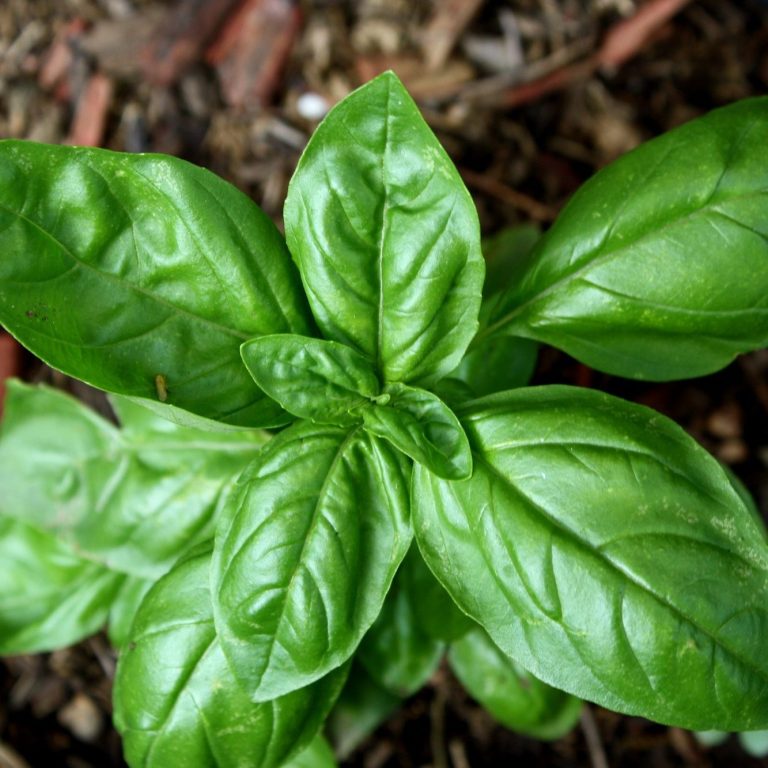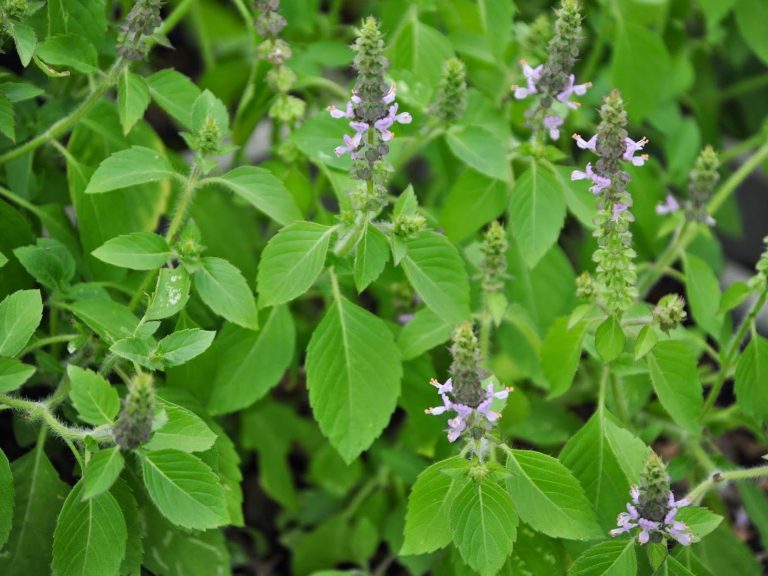Basils

Sweet Basil
Sweet basil and Genovese basil are closely related, and their names are frequently used interchangeably. However, they are distinct varieties. Sweet basil typically has lighter green leaves, which are less rounded and more pointed compared to Genovese basil. The flavor of sweet basil is somewhat sweeter and gentler, with a subtle hint of anise or licorice.
Native Area: Central Asia, Southeast Africa
USDA Hardiness Zones: 9 to 11
Sun Exposure: Full sun to partial shade
Mature Height: 12 to 24 inches

Purple Basil
Several varieties of purple basil exist, with Osmin purple basil being one of the most prevalent. It boasts a vibrant deep purple hue with blue-black shades, often considered the darkest among purple basils. Its spicy, clove-like taste makes it ideal for fresh use in salads or as a garnish. The plant's deep purple blossoms are also edible and can enhance a salad's visual appeal and flavor.
Native Area: Africa, Asia
USDA Zones: 9 to 11
Sun Exposure: Full sun to partial shade
Height: 12 to 24 inches

Holy Basil
Holy basil (Ocimum tenuiflorum), native to Southeast Asia, is utilized in Indian medicine to address various conditions, including eye diseases and ringworm infections.
Used in Ayurvedic medicine as a treatment for many health issues including stress relief, kidney stones, colds, fevers, bronchitis, asthma, and sore throats, to name a few.
Distinct from the sweet basil used in marinara sauce or as a Thai culinary herb, holy basil, also known as Ocimum sanctum L. and tulsi, is esteemed as a restorative for the body, mind, and spirit. Different parts of the plant serve different medicinal purposes:
- Fresh flowers are suggested for bronchitis treatment.
- Leaves and seeds, when mixed with black pepper, are employed against malaria.
- The whole plant is beneficial for treating diarrhea, nausea, and vomiting.
- Formulations such as pills and ointments are created for eczema.
- Alcohol extracts are utilized for stomach ulcers and eye conditions.
- Essential oils extracted from the leaves are applied to insect bites.
Comprehensive research supports the therapeutic use of the entire holy basil plant. It is also nutritionally rich, offering vitamins A and C, calcium, zinc, iron, and chlorophyll.
Reducing Stress and Anxiety
Every part of the holy basil plant functions as an adaptogen, a natural agent that assists the body in adapting to stress and fostering mental equilibrium.
While the idea of an adaptogen is rooted in holistic tradition, scientific studies confirm that holy basil possesses pharmacological qualities that aid in managing various stress forms.
Stress can originate from:
- Chemical sources
- Physical factors
- Infectious agents
- Emotional triggers
In physical stress scenarios, holy basil has been observed to boost endurance in animals. Those given holy basil leaf extracts and subjected to stress-inducing environments demonstrated:
- Enhanced metabolic function
- Prolonged swimming endurance
- Reduced tissue damage
- Decreased stress levels in noisy settings
Studies involving humans and animals have noted reductions in:
- Stress
- Sexual dysfunction
- Sleep disturbances
- Forgetfulness
- Fatigue

Lemon Basil
Lemon basil, also known as Thai lemon basil or hoary basil, is a hybrid commonly used in Southeast Asian cuisine. Its leaves have a robust texture that withstands high cooking temperatures well. The plant offers a pleasant lemony scent and a subtle lemon taste, complementing its spicy basil undertones.
Native Area: Africa, Asia
USDA Hardiness Zones: 9 to 11
Sun Exposure: Full sun to partial shade
Mature Height: 12 to 24 inches

Thai Basil
Thai sweet basil is a favored herb in Southeast Asian cooking, especially in Thai dishes. Its striking plants make an impressive display in any herb garden, characterized by deep purple stems and blossoms. The leaves are slightly thicker than those of sweet basil, offering a subtle yet intricate flavor. Thai sweet basil retains its flavor even when cooked at high temperatures.
Native Area: Africa, Asia
USDA Hardiness Zones: 9 to 11
Sun Exposure: Full sun to partial shade
Plant Height: 12 to 24 inches
We need your consent to load the translations
We use a third-party service to translate the website content that may collect data about your activity. Please review the details in the privacy policy and accept the service to view the translations.

